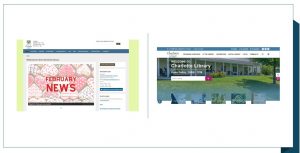Feb
19

Posted by Sarah Levin-Lederer on February 19th, 2024
Posted in: Funded Project, Member Spotlight
Tags: Funded Projects, Member Spotlight
Thank you to Library Directory Margaret Woodruff and Tech Librarian Susanna Kahn for today’s guest post from the Charlotte (VT) Library about how they used an NNLM R7 Technology Improvement Grant to update the library’s website.

The Charlotte Library website before updates (L) and after (R).
The Charlotte Library primarily serves the small town of Charlotte, Vermont (pop. 3800). With no community center, recent loss of the local health center and consolidation of services in our school district, the library’s role as a community hub, information source and activity center is increasingly important.
Our website was over 12 years old. It looked outdated and proved challenging for patrons to use as the clunky, outdated navigation and lack of search mechanism made it difficult to find information. Most concerning, our site was not meeting accessibility standards, perhaps preventing people with visual impairments from accessing library services.
In addition to the difficult user interface, the website was also a challenge for library staff to manage. Updating content was time consuming and inserting text or an image could cause formatting issues that required coding to fix. This challenge has affected the ability to get out information, such as emergency announcements or updates to ongoing community issues, particularly noticeable during COVID. An in-house analysis determined that full overhaul was required to make it user friendly and accessible for patrons and website administrators.
Community partners: Vermont Association for the Blind and Visually Impaired, Office for Deaf and Hard of Hearing, Emergency Management, Charlotte Senior Center
Our community partners provided important accessibility information and suggested links and resources. We look forward to engaging with our community partners to access their information and sites once the website design is complete.
The migration phase was recently completed and training scheduled to begin soon. We will then have access to the website platform and the ability to make changes and additions. After the training we will request any errors be corrected. The committee will review the website. After all issues are resolved the site will go live! We will publicize the new website and hold a launch party, offering information sessions on using the new site including highlighting health and safety information.
Choosing a Website Design Company
The Process
This project would not have been possible without the generous grant from NNLM. As noted in our grant application, COVID led to increased requests for online health information. This new site will allow increased access to the wellness and research pages on our new site that link to MedlinePlus. Additionally, there will be room to include information about All of Us Research Program as well as the NNLM Reading Club and other timely health information.
We are excited to have a greater role as a public library in creating a healthy community!